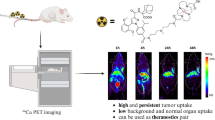Summary
The effect of targeted magnetic nanoparticles on hepatoma and the underlying mechanism were examined. Nude mice transplanted with a human hepatoma cell line (HepG2 cells) were randomized into 5 groups, including: (1) group A, receiving normal saline, (2) group B, receiving 5-fluorouracil (5-Fu), (3) group C, receiving magnetic nanoparticles containing 5-Fu, (4) group D, consisting of treatment with magnetic nanoparticles containing 5-Fu and inside magnetic field and (5) group E, receiving pure magnetic nanoparticles and inside magnetic field. Morphological features of transplanted tumors in mice in each group were observed under transmission electron microscope (TEM). The expression of bcl-2/bax protein was immunohistochemically detected by SABC method. The results showed that a large number of apoptotic tumor cells were found in group B and group D under TEM. The expression of bcl-2 protein was significantly decreased and the expression of bax protein increased significantly in both group B and D as compared with those in group A, C and E (P<0.01 for all). The decrease in bcl-2 and the increase in bax were more in group D as compared with group B (P<0.01). It is concluded that the targeted magnetic nanoparticles containing 5-Fu can improve the chemotherapeutic effect of 5-Fu by decreasing bcl-2 expression, increasing bax expression and inducing apoptosis of the liver cancer cells.
Similar content being viewed by others
References
Gong L S, Zhang Y D, Liu S. Target distribution of magnetic albumin nanoparticles containing adriamycin in model of transplanted liver cancer in rats. Chin J Hepatobiliary Surg (Chinese), 2003,9(9):543–546
Parkin D M, Pisani P, Ferlay J. Estimates of the worldwide incidence of 25 major cancers in 1990. Int J Cancer, 1999, 80:827–841
Tang Z Y, Sun F X, Tian J et al. Metastatic human hepatocellular carcinoma models in nude mice and cell line with metastatic potential. World J Gastroenterol, 2001,7:597–601
Zhou X D, Tang Z Y, Yu Y Q et al. Recurrence after resection of fetoprotein-positive hepatocellular carcinoma. J Cancer Res Clin Oncol, 1994,120:369–373
Shuto T, Kinoshita H, Hirohashi K et al. Indications for and effectiveness of a second hepatic resection for recurrent hepatocellular carcinoma. Hepatogastroenterology, 1996,43:932–937
Blum H E. Molecular targets for prevention of hepatocellular carcinoma. Dig Dis, 2002,20:81–90
Kogure T, Ueno Y, Iwasaki T et al. The efficacy of the combination therapy of 5-fluorouracil cisplatin and leucovorin for hepatocellular carcinoma and its predictable factors. Cancer Chemother Pharmacol, 2004,53(4):296–304
Tainok H, Tsuiji A, Morita S et al. Combination chemotherapy with continuous 5-fluorouracil and low-dose cisplatin infusion for advanced hepatocellular carcinoma. Anticancer Res, 2003,23(2C):1891–1897
Pohl J, Zuna I, Stremmel W et al. Systemic chemotherapy with epirubicin for treatment of advanced or multifocal hepatocellular carcinoma. Chemotherapy, 2001,47(5):359–65
Murata K, Shiraki K, Kawakita T et al. Low-dose chemotherapy of cisplatin and 5-fluorouracil or doxorubicin via implanted fusion port for unresectable hepatocellular carcinoma. Anticancer Res, 2003,23(2C):1719–1722
Dizon D S, Kemeny N E. Intrahepatic arterial infusion of chemotherapy: clinical results. Semin Oncol, 2002,29(2):126–135
Zhang Y D, Gong L S, Pan Y F et al. Target distribution of magnetic nanoparticle containing drug in vivo and its therapeutical efficiency for liver cancer. China Journal of Medical Engineering, 2003,11(6):18–21
Lv D P, Li L J, Liu X Q. Nanotechnology and treatment and prevention of tumor. Chin J Prac Surg (Chinese), 2002,22(2):126–128
Clark J W, Glicksman A S, Wanebo H J. Systemic and adjuvant therapy for patients with pancreatic carcinoma. Cancer, 1996,78(3 Suppl):688–693
Yan X, Fraser M, Qiu Q et al. Over-expression of PTEN sensitizes human ovarian cancer cells to cisplatin-induced apoptosis in a p53-dependent manner. Gynecol Oncol, 2006,102(2):348–355
Grivicich I, Regner A, da Rocha A B et al. The irinotecan/5-fluorouracil combination induces apoptosis and enhances manganese superoxide dismutase activity in HT-29 human colon carcinoma cells. Chemotherapy, 2005,51(2–3):93–102
Kerr J F, Winterford C M, Harmon B V. Apoptosis its significance in cancer and cancer therapy. Cancer, 1994, 73(8):2013–2026
Yang E, Zha J, Jockel J et al. Bad, a heterodimeric partner for Bcl-XL and Bcl-2, displaces Bax and promotes cell death. Cell, 1995,80(2):285–291
Gottschalk A R, Boise L H, Oltvai Z N et al. The ability of Bcl-x(L) and Bcl-2 to prevent apoptosis can be differentially regulated. Cell Death Differ, 1996,3(1):113–118
Juin P, Hunt A, Littlewood T et al. c-Myc functionally cooperates with Bax to induce apoptosis. Mol Cell Biol, 2002,22(17):6158–6169
Yao H, Li P, Venters B J et al. Histone Arg modifications and p53 regulate the expression of OKL38, a mediator of apoptosis. J Biol Chem, 2008,283(29):20060–20068
Keane M M, Ettenberg S A, Nau M M et al. Chemotherapy augments TRAIL-induced apoptosis in breast cell lines. Cancer Res, 1999,59(3):734–741
Wang Z, Song W, Aboukameel A et al. TW-37, a small-molecule inhibitor of Bcl-2, inhibits cell growth and invasion in pancreatic cancer. Int J Cancer. 2008,123(4):958–966
Duan X X, Ou J S, Li Y et al. Dynamic expression of apoptosis-related genes during development of laboratory hepatocellular carcinoma and its relation to apoptosis. World J Gastroenterol, 2005,11(30):4740–4744
Author information
Authors and Affiliations
Additional information
Jianming WANG, male, born in 1968, Associate Professor
This project was supported by a grant Foundation of National 863 Program (No. 2002AA214061).
Rights and permissions
About this article
Cite this article
Wang, J., Xiao, B., Zheng, J. et al. The effect of targeted magnetic nanopaticles on hepatoma and the expression of bcl-2/bax protein. J. Huazhong Univ. Sci. Technol. [Med. Sci.] 28, 443–446 (2008). https://doi.org/10.1007/s11596-008-0415-z
Received:
Published:
Issue Date:
DOI: https://doi.org/10.1007/s11596-008-0415-z




